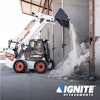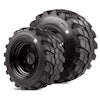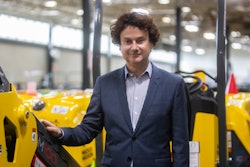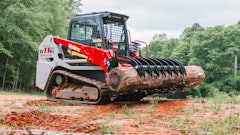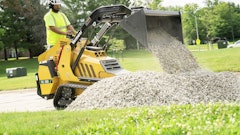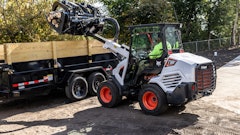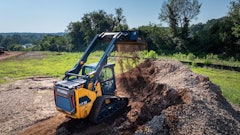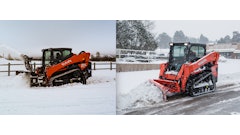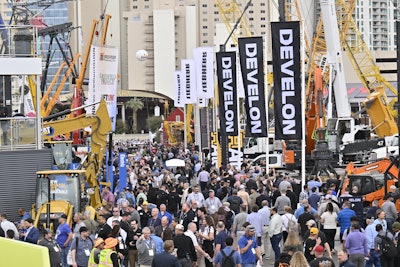
Of all the new construction heavy equipment product launches at CONEXPO-CON/AGG, one of the hottest product categories was the compact track loader (CTL). Equipment makers have revamped and upgraded the design and technology of their existing models, and many showcased entirely new machines. The clamor to create the latest generation of CTLs was sparked by an industry need for equipment that is easy-to-use for new operators and powerful enough for land-clearing construction jobsites. As in past years, compact equipment was once again a popular choice to meet the various needs of the modern worksite.
“We’re seeing more and more customers, big and small, looking to push the limit when it comes to what a compact track loader can do on a jobsite, said Luke Gribble, solutions marketing manager for John Deere. “They’re asking for a solution that can push more dirt, can grade more accurately, can run hydraulic attachments a lot more efficiently and effectively and are utilizing bigger and more complex attachments, too, with that.”
The entire industry is seeing an increase in CTL use and buying. Market research firms predict CTL market demand to increase 5%-10% throughout the next decade. Equipment makers are creating many improvements to CTLs, which are known for their low ground pressure and task versatility, to increase sales at a compound annual growth rate (CAGR) of 5.2% by 2031 globally, according to Transparency Market Research. While the market reached about $3.2 billion in sales in 2022, it’s expected to grow to $4.8 billion by 2032, a CAGR growth rate of 3.8%, according to market research firm Fact.MR. Meanwhile, TechSci Research predicts the CTL and skid steer segment will grow at a CAGR of 10% by 2026 due to demand, stating that CTLs dominate the market and the trend is likely to continue due to broad uses of the equipment.
‘Bigger is Better’ Philosophy
Most construction heavy equipment producers told Equipment Today that they are seeing increased demand for larger CTLs. Contractors are turning to CTLs more often because they are easy for new operators to learn, during a time when the industry is short 546,000 workers, according to Associated Builders and Contractors. Versatile compact equipment also allows contractors to do more with less.
Deere introduced its largest-ever CTL at CONEXPO, the 118-gross-hp 335 P-tier with load-sensing hydraulics. The 335 will be available in early 2024.
“Traditionally, what we see is that skid steers and CTLs are easier to operate. They're more comfortable in the field for new operators,” he said. “They're not as intimidating to operate as some other pieces of construction equipment. I think that's attracting a lot of customers into utilizing a CTL more on their bigger jobs, instead of more of a secondary piece of equipment. And you can utilize more attachments on the machine, instead of having multiple machines. That's another shift that we're seeing in that space, which is why we're putting such a focus on attachment performance.”
CASE, which introduced the world’s largest CTL, the 16,000-lb. TV620B, in 2021, displayed a variety of CTL sizes at CONEXPO this year, debuting the TL100 mini track loader with an operating capacity of 1,000 lbs. The medium and larger frame CTLs are getting a lot of attention at CASE. Part of the reason behind the popularity of the larger CTLs is the “cool” factor, said Jeff Jacobsmeyer, product manager at CASE Construction Equipment.
“I think we all like to think we have a sense of self control, but like many other things in life, you see the biggest and baddest tool, and you want it,” he said. “So you may not need more horsepower, and you may not need a CTL that weighs more than 16,000 lbs., and you may not need all that auxiliary hydraulic power, but you definitely want it. That is certainly part of the phenomenon that has contractors looking at larger, more powerful equipment.”
There are several reasons for bringing a larger machine into the fleet, such as growing a business, he said.
“A machine like the TV620B may be more machine than you need today, but as you grow your business, it has the ability to load larger trucks, lift heavier loads, run more demanding attachments – you’re essentially specifying that added performance into your business growth and development,” Jacobsmeyer said. “Having said that, medium frame CTLs offer the best of both worlds: machines with strong horsepower and operating capacities, as well as machines with lower horsepower ratings that deliver even more simplified maintenance, while still delivering great performance and capacities. Between size classes, lift geometries, rated operating capacities and attachment strength, there are many great options in that medium-frame size class.”
The larger CTLs perform well in grading and material-handling applications, as well, said Kevin Coleman, product specialist at Caterpillar.
“Many customers are also looking to the larger, high-hp CTLs to deliver high performance and productivity when paired with high performance hydro-mechanical attachments,” he said. “The larger models have grown in popularity not only due to customers finding new ways and applications in which to use the larger machines with the higher load handling and hydraulic horsepower capabilities. The larger, more powerful CTLs deliver a machine and attachment combination designed to bring unparalleled speed and quality when paired with tools such as mulching heads or cold planers/milling heads.”
At Doosan Bobcat, mid-frame CTLs are the long-term market driver, but there is also demand for large-frame models, said Julie Portillo, loader marketing manager.
“A variety of CTL sizes will continue to be in demand because they are among the most versatile tool-carrying, multi-purpose machines available on today’s jobsites,” she said. “The increased floatation provided by their track systems makes them ideal on a wide range of jobsites with soft ground surfaces such as sand, mud and clay. With their weight distributed throughout the track and ground contact area, CTLs can travel across uneven ground more efficiently and are better at maneuvering through softer ground conditions. This can be a significant advantage.”
Specific jobsite needs are another reason for the trend toward larger CTLs, said Ryan Anderson, product marketing manager for New Holland Construction North America.
“As subdivisions get smaller with tighter property lines, the need, and demand, for medium frame CTLs grows,” he said. “Overall trailer weight is also something that is constantly on customers’ minds. If they can get the same job done with a lighter, medium frame machine, customers will do so in order to avoid costly overweight expenses.”
DEVELON launched its first CTL, the DTL35, at CONEXPO. The 12,604 lb. machine has 116 hp and an operating capacity of 3,657 lbs.
“The combination of the horsepower and the rated operating capacity make this vertical-lift-path compact track loader an ideal choice for earthmoving contractors,” said Thomas Lee, director of product management for DEVELON. “Both the horsepower and auxiliary hydraulic flow make this size class a popular choice for heavy-duty construction and site prep projects. Our first compact track loader will be available for use with land-clearing attachments.”
Hyundai Construction Equipment Americas brought with it to CONEXPO its re-entry into the CTL market, the HT100V, which was designed to provide increased vertical lift.
“This lift path was chosen because the geometry of the arm allows the boom to raise the bucket straight up to full height,” said Adam C. Ford, product manager, Hyundai. “Our HT100V provides the best of both worlds: powerful engine, robust structural construction, superior lifting capacity of a large frame machine and low ground pressure and maneuverability of a smaller frame machine.”
Hyundai entered the medium-frame market with its re-entry into the CTL segment, he said.
“The largest portion of the CTL market is the medium frame segment, and we targeted this segment specifically to give our dealer partners the ability to support the largest portion of customers,” Ford said.
Meanwhile, Yanmar Compact Equipment North America entered the CTL market for the first time at CONEXPO, with its TL65RS, TL75VS, TL80VS and TL100VS models, ranging from 67 hp to 103.5 hp and Tier 4 Final diesel engines. Yanmar, too, is seeing a pivot to larger CTLs.
“We’ve seen a shift from the smaller frames to the mid frame to larger frame sizes, said Buck Storlie, product manager for Yanmar. “They’re looking for the machines to do more, more, more. CTLs continue to replace skid steers as their transportability and uses are increasing.”
Also at CONEXPO, ASV unveiled its VT-100 and VT-100 Forestry CTLs. Designed for mulching, right-of-way clearance and construction site prep, Storlie said the models are ideal for owners who need a mid-range machine.
“They are the perfect option for those looking for a little more power than the RT-75 without having to go to the heavy hitter of all CTLs; the RT-135,” he said. “We’ve seen a shift from the smaller frames to the mid frame to larger frame sizes. They’re looking for the machines to do more, more, more,” Storlie said. “CTLs continue to replace skid steers as their transportability and uses are increasing.”
Weighing in at 1,890 lbs., Wacker Neuson’s ST27 CTL was released at CONEXPO. It’s the company’s smallest in its mid-range CTL lineup.
“In general, there is in fact a trend toward large frame loaders, while medium frame loaders, like the ST27 have remained fairly stable,” said Doug Clark, Wacker Neuson product manager for compact equipment. “The growth in the large frame loader segment seems to be coming from small frame loaders. It seems as if, across all customer segments, users are embracing a “bigger is better” philosophy.”
At Manitou, customers are trending toward larger machines to achieve greater operating capacity, said Nathan Ryan, product line manager for skid steers and CTLs at the company.
“Even as you look at what is traditionally considered a ‘medium frame’ compact track loader – that’s in the 1,800 to 2,400 lbs. capacity range — our new range beefs that up between 2,100 and 2,750 lbs. of rated operating capacity. People are looking to be able to do more but don’t always want the footprint that comes with large-frame or extra-large frame CTLs,” he said.
Takeuchi-US is also seeing a shift toward higher-capacity CTLs, during the past several years.
“Both (medium and large frame) sizes are appropriate for traditional dirt work,” said Lee Padgett, product manager for Takeuchi. “For residential work or landscaping, medium-frame CTLs are easier to maneuver around the jobsite and to trailer from place to place. Applications like mulching often require higher hp and gpm for the auxiliaries.”
Kubota’s SVL75-3 also made its debut at CONEXPO. The 74.3 hp machine has a higher peak torque and a number of updates.
“The new Kubota SVL75-3 incorporates a number of new features, as well as features taken from other products in the Kubota lineup,” said Jerry Corder, Kubota product manager, construction equipment.
The JCB 300T Compact Track Loader has a 74 hp JCB EcoMAX engine which requires no DEF, DPF or engine aftertreatment. A rated operating capacity of 3,000 lbs. (1,360 kg) means the 300T is meant for lifting and loading, digging and to be used with multiple attachments, the company said.
Big Power, Easier Maintenance in a Small(er) Package
Many of the equipment makers have increased the power and lift available in their newest CTLs. Not only do these models feature more horsepower, but they also have improved hydraulics for better attachment control and breakout force, as well as enhanced servicing accessibility. As the market increases for CTLs, equipment makers are adding more features and functionality, including improved lift. Many of the new and upgraded machines have further reach, greater lift capacity and better stability.
CASE’s TV620B offers with 114 hp, has an operating capacity of 6,200 lbs. (50% of tipping load) and includes electro-hydraulic controls and high-flow hydraulics.
“It also features some of the industry’s strongest breakout forces – 12,907 lbs. at the bucket, 12,084 at the lift cylinders – and it comes standard with High Flow hydraulics that offers 41.6 gpm for the demanding hydraulic-powered attachments,” Jacobsmeyer said. “AUX flow can be set by using the Hydraulics on Demand feature through the monitor to dial in the specific flow needed for efficient operation.”
When it comes to suspension, CASE recently announced the availability of the CASE EZ Trac suspension on its large frame and extra-large frame CTLs, including the TV620B.
“The bogie wheel system in the middle of the track frame absorbs the rough terrain as the machine goes over it, delivering a smoother ride. It delivers greater traction as the bogey wheels allow you to stay in contact with the surface at all times, so the track is always engaging the ground,” he said. “It also allows the operator to hold a more exact grade, as there’s no torsion movement between the frame and the undercarriage, and truck loading is improved, as you’ve got an even more solid base with no porpoising when dropping heaped buckets into the back of trucks, even at full height.”
All service points are accessible for maintenance and repairs at ground level, and the machine utilizes SiteConnect Module and CASE SiteWatch telematics for improved monitoring.
Last fall, Bobcat launched its most powerful CTL to date, the T86, which is equipped with a 105 hp Tier 4 engine and has an 12,393 lb. operating weight.
“We’ve boosted the horsepower for the T86 while optimizing machine weight,” Portillo said. “The result is greater lifting capabilities, impressive breakout forces and leading maneuverability for fast cycle times.”
The T86’s vertical lift path provides higher lift capacity and more reach at full lift height than radius lift path, to keep the load closer to the machine while raising. The machine has three hydraulic flow options, including standard, which offers 23 gpm and 3,500 psi, up to super flow, which provides 42 gpm and 4,061 psi.
Bobcat’s R-Series loaders, including the T86, are available with the 5-Link Torsion Suspension undercarriage.
“It dramatically reduces stress and vibration, making the ride more comfortable,” she said. “An additional pivot point improves ride quality, and a unique fifth link included in the rear axles provides a more comfortable ride. Other components like wider track rollers, dual flange front idlers and a longer track further improve the ride of the machine. The lengthened track of the undercarriage increases surface area and ground contact for better flotation.”
Meanwhile, Cat’s D3 Series CTLs come in multiple sizes, starting at the 239D3 and the 249D3, which weigh less than 8,000 lbs., omitting the need for a commercial driver’s license. The larger-frame models, such as the 279D3 and the 289D3, offer more rated capacity and higher lifting heights, as well as increased hydraulic horsepower, Coleman said. Of the series, the 299D3 and the 299D3 XE have the largest load handling capacities and highest horsepower at 98 hp/110 hp.
The Cat CTL models are equipped with a torsion suspension system that attaches to the machine chassis with four torsion axles. Those axles require daily greasing, and the grease points are accessible at ground level.
“The suspension provides a more comfortable ride, along with greater load retention (even when using the standard two-speed travel) when compared to competitive rigid undercarriage designs,” Coleman said. “More comfort means higher speeds on the job, which translates into higher productivity. The suspension also helps keep the tracks on the ground during digging and grading to provide maximum traction at all times.”
In recent years, Deere introduced its Anti-Vibration Undercarriage System, and it’s available on the new 333 and 335 models.
“That system is designed to increase operator comfort when you're going over, I would say, rough terrain on a jobsite. We've actually isolated the undercarriage from the machine frame itself,” Gribble said. “There's also a bogie roller system incorporated into that undercarriage. If you're going over small rocks or small piles of dirt on the jobsite, you're able to keep the whole track ideally on the ground.”
One of Deere’s goals is to make equipment, especially CTLs, easy to service. These CTLs have a rear hood that opens for access and two side panels that can be taken off to view filters, access fluids and conduct daily checks.
“There's just a couple of bolts on the cab itself that you can take off with the cab up,” he said. “And if you do need to get into some more in-depth repairs, you've got full access to some of the major systems underneath the machine. Between the ease of maintenance at the rear, and then the ability to raise the cap very easily and access some of the more complex components, we're going to continue to make that a focus with this next generation of machines.”
DEVELON’s DTL35 comes in at 12,604 lbs. and has a rated operating capacity of 3,657 lbs. The vertical-lift-path compact track loader comes with a choice of two track widths: 15.7 in. and 17.7 in.
“The wider tracks will allow for less ground pressure in situations where operators are moving the machine across established surfaces for reduced disturbance,” Lee said. “The tracks will be available with either a block pattern or multi-bar pattern.”
When it comes to servicing the equipment, the DTL35 comes with a tilting cab for better access.
“When operators open the rear tailgate, they will have access to the key service components: diesel engine, battery, filters and fluid fills,” he said. “Above the rear tailgate area is the machine’s cooling system, which is also easy to access after lifting a top panel protecting the internal components. Operators working in extremely dusty and dirty conditions can easily access the cooling system to remove debris and minimize machine overheating issues. The radiator fan is also auto reversible, which can be very beneficial in dusty environments.”
DEVELON’s CTLs are powered with D34 diesel engines and have a sloped undercarriage to reduce debris buildup.
One of the more popular CTLs at CONEXPO was New Holland’s C330. New Holland is known for creating the vertical lift skid steer loader in the 1980s and the first version of its SuperBoom.
Today, the vertical lift C330 has a 67 hp engine and its SuperBoom.
“The patented SuperBoom vertical lift geometry is a huge factor for us,” Anderson said. “Some of the key advantages of the SuperBoom vertical lift are great hinge pin heights for dumping into higher containers and/or trailer, excellent bucket reach (essential for precision loading) and use of attachments.”
On large frame models like the C345 and C362, New Holland offers TerraGlide track suspension, bogie-style design for working in harsh conditions. Fluid levels and grease points should be checked daily, and the oil change interval is at 500 hours.
“Checking track tension every day is important to ensure longer track life and safe performance of the machine,” he said.
Hyundai added an entirely new track system to its HT100V CTL
“The suspension of this track system consists of a coil spring and shock damper, providing the operator with superior ride quality and load stabilization when traversing rough or uneven terrain,” Ford said.
The 69.7 hp model comes standard with two-speed travel is equipped with the Hyundai Escort system, which when the engine is turned off, the working lights on the front and rear remain on for 30 seconds to improve safety. Its preventative maintenance includes Hi Mate remote management with GPS satellite technology to access diagnostic information and verify equipment locations.
Yanmar’s TL100VS has a standard 40 gpm high flow with a 3,600 lb. standard operating capacity and 10,286 lb. tipping load.
“The hydraulic system improvements make it easier to multi-task,” Storlie said.
The TL100VS has an optional load sensing system, work tool positioner, return-to-position technology, self-leveling, ride control and auto two-speed capabilities. The new construction-grade loader features a torsion axle suspended undercarriage with a pivot link system at the rear axle. This linkage technology uses a spring load to reduce oscillation and stabilize the machine, helping support material retention and ride quality. Additionally, the TL100VS includes large line sizes, hydraulic coolers and direct-drive pumps, transferring more flow and pressure directly to the attachment and reducing power loss.
“The undercarriage is a new design for the Yanmar model. It’s a steel embedded design, with standard suspension, best in class ride capabilities and traction,” Storlie said.
ASV’s VT-100 and VT-100 Forestry CTLs come equipped with a 103.5-hp Tier 4 Final Yanmar diesel engine and standard 40 gpm high flow. The VT-100 features a 3,500-lb. rated operating capacity and 10,286 lb. tipping load while the VT-100 Forestry includes a 3,700-lb. rated operating capacity and a 10,571 lb. tipping load. The models include Posi-Track rubber track suspension with suspended wheels and axles, allowing it to manage various terrains. The models also have accessible daily checkpoints and removable skid plates for cleaning when needed and include three-panel engine access with a swing-out radiator that requires no tools to open.
“The ASV CTLs are for the premium, performance buyer looking for more high-cooling capacity and luxury options like in the VT Forestry model,” Storlie said.
Wacker Neuson’s ST27 has a hinge pin height of 120 in., with a dump height of 94.3 in. The company claims the ST27 has the best power-to-weight ratio in its class with an operating weight of 7,310 lbs. and a 74.3 hp engine. The design also maximizes the rated operating capacity of 1,890 lbs. (at 35% of tip), while providing extra reach at max height making it easier to dump material into the center of a dump box and keeps the loader farther away from the vehicle or trailer being loaded,” Clark said.
When the loader arms are down, the cab tips forward, allowing access to the hydraulic system and the engine compartment openings.
“It’s purposefully designed to ensure the most frequently accessed components are also the easiest to access,” Clark said. “The easy-to-clean sloped undercarriage design sheds mud and debris while you work reducing wear and cleanout time. The ST27 features lubricated and sealed forged steel rollers and idlers that require less maintenance, extend track life and are more durable than rubber coated rollers.”
Kubota’s SVL75-3 load arms have been redesigned for a taller hinge pin height – nearly 3 in. higher than the SVL75-2 – and improved rear visibility, Corder said.
“We have borrowed the Advanced Multifunction Valve from the SVL65-2, which allows for enhanced, simultaneous machine and attachment operation,” he said. “The auto-downshift feature from Kubota compact excavators has been incorporated, as well. This function automatically shifts from high to low range when executing a turn for a smoother ride and maximum available torque when exiting the turn.”
Kubota has also adopted its skid-steer loader engine layout, putting the radiator on top and moving the fuel tank to the rear bonnet.
“This opens up the engine bay to provide unimpeded access to the battery, all filters, and all fluid fill locations for easier routine maintenance,” Lee said. “The suspension design is a welded frame undercarriage to ensure durability and longevity, omitting wear part costs.”
When it comes to breakout force, Manitou has improved its by 12% compared to previous models and has increased fuel tank size by 14% for extended run times, Ryan said. The company introduced its entirely new lineup of CTLs at CONEXPO 2023, and that includes three new models ranging from 2,100-lbs. of rated operating capacity up to 2,750 lbs. in rated operating capacity (35% of tipping load). For contractors who reference the 50% tipping load metric for rated operating capacity, it ranges between 3,000 and just under 4,000 lbs., he said.
“We have focused on five very specific areas of improvement for these machines: safety, comfort, productivity, simplification and serviceability,” Ryan said. “All models are vertical lift and feature a new lift arm design, and the operator’s station has been improved.”
Each of these loaders includes Manitou’s IdealTrax automatic track tensioning system, which keeps the proper amount of tension on both tracks. Instead of greasing to achieve proper tension every 50 hours or so, a hydraulic system is used to keep constant tension on the tracks.
“You’re also going to see improved idler and bogie bearing life. It eliminates tensioning with a grease gun,” Ryan said. “And the track immediately releases tension when not in operation, making cleanout super easy; and it also simplifies track removal and installation.”
Takeuchi’s newest CTL, the TL8R2, includes high-flow auxiliary hydraulics, creep control, auto two-speed travel and a new undercarriage. The undercarriage is welded directly to the frame for greater strength and rigidity, Padgett said. The TL8R2 has a ride control feature for traveling at higher speeds for longer distances to help retain the material in the CTL’s bucket. The 300T comes with boom suspension, which can be turned on or off for precise boom control.
“Its new undercarriage design features repositioned travel motors with internally routed drive lines and double and triple flange track rollers,” Padgett said. “This track loader comes standard with many new features.”
The JCB 300T Compact Track Loader has a JCB EcoMAX engine, which requires no DEF, DPF or engine aftertreatment. JCB’s CTL models include the single-arm JCB Powerboom and side-door entry. With a rated operating capacity of 3,000 lbs., the 300T is designed for lifting and loading, digging and pushing while using a variety of attachments, including blades, tilers and trenchers, grapple buckets, rakes and more. Its welded chassis provides rigid structure for reduced weight, while the Powerboom protects the hydraulic hoses from impact, and greater breakout force is provided by the largest quick-hitch pivot pins in the industry, the company said.
While Caterpillar did not release any new CTLs at CONEXPO, it did launch its D3 series CTLs in 2019.
Insider Knowledge: What to Expect From the Cab
Keeping up with the countless technological innovations taking place in the construction industry is no easy task. Owners and operators will likely see the many of those improvements in the cab, as controls, touchscreens and other dashboard electronics have improved. Certainly the improvements in joystick ergonomics and seating comfort cannot go unnoticed, as well. Most equipment makers have made improvements to the cab in recent years and CTL cab upgrades are no exception.
For the past decade, an ongoing trend has been the one-piece cab. Kubota’s SVL75-3 has a new one-piece cab that is sealed to reduce dust, dirt, most noise and other elements. There is also a 7-in. touchscreen, keyless start, a wide-angle 176° backup camera and relaying of machine vitals, Corder said.
Deere did a complete redesign of its cab and also offers a one-piece design in its new CTLs.
“There are a lot of features that we're adding or making as optional to take operator comfort really to the next level,” Gribble said. “The cab itself, the structure, we moved to a one-piece design, that's going to lower the noise inside the cab for operators, which is great for the jobsite, especially when running attachments. It's also going to help keep some of the elements out if you're in heavy rain or heavy snow, so that's going to be a big plus to keep our operators more comfortable.”
New technology will be incorporated into the cab, with asset location, improved maintenance monitoring and larger touchscreens, for example. A heated/cooling ventilated seat will be available, as well as Bluetooth connectivity and customizable joysticks.
“You can actually move them forward or backwards, depending on kind of how where your arms rest on the machine, how long your arms are, that's going to be something new that you couldn't get previously,” Gribble said of the joysticks. “The features are suited for a machine that's going to be run all day long for both owner and operators, or for larger companies, as well. I think that will help keep operators in the machine and again, that kind of helps with some of that retention of operators and attracting talent to the industry.”
When Caterpillar released its D3 series CTLs with a one-piece sealed and pressurized cab back in 2019, the enclosed cab came standard. The cab door was wider than in the past and the distance between joystick pods had increased by 3 in.
At DEVELON, engineers have spent considerable time designing the CTL cab for operator comfort and ease of use, Lee said.
“Our compact track loader cab offers a large interior space for operators that will come standard with electrohydraulic joystick controls for easy operation and less fatigue,” he said.
Among the standard equipment is a rearview camera to improve visibility, which is displayed on an 8-in. touchscreen, as well as Bluetooth connectivity for phone conversations and to listen to music. Additional options include an air suspension, heated seat and 360° monitoring system.
Manitou’s new CTL lineup includes a cab that is 23% larger than older versions and has 23% more visibility.
“Each unit features a patent-pending sloped roof that provides better visibility, and uniquely shaped patent-pending vertical lift arms that reduce material buildup and increase visibility under the arm to the outer tracks,” Ryan said. “Ride Control is now standard, which delivers a smoother and more comfortable ride.”
Joysticks are now standard, and the seat and armrests are independently adjustable. A 7 in. color display shows operation data with telematics, and the rearview camera footage.
“A foot throttle is now standard to increase and decrease engine speed without removing hands from the joysticks – and that also can act as a deceleration pedal when the hand throttle is set to high idle,” he said. “Each machine also features an optional creep mode, which is rare on machines with pilot controls.”
Meanwhile, Takeuchi’s TL8R2 cab includes the “automotive-style” cab that is becoming more popular in the industry, with a high-back suspension seat, electronic throttle control, rocker switches, 12V outlet and cup holder. The roll-up door pressurizes the cab, sealing in the air conditioning, heating, defrost capabilities and more. There is also an AM/FM radio with Bluetooth connectivity. The 5.7-in. color screen displays operation data and rearview camera footage, as well. Additionally, its LCD display is 8 in.
New Holland’s C330 has customizable electro-hydraulic (EH) controls for operators of any skill level.
“Electro-hydraulic controls (EH) are our preferred method of operating compact track loaders and skid steers,” Anderson said. “Different from Pilot Control, EH controls send an electrical signal to the pumps, which allows them to be ‘tuned’ to the operator’s needs.”
Hyundai’s HT100V has a cab with a vertical sliding door, ergonomic multifunction joysticks, a mechanical suspension seat, five-vent HVAC, foot pedal, rotary-dial throttle and Bluetooth.
Bobcat’s T86 has selectable, ergonomic joystick controls.
“Three workgroup response settings allow operators to adjust the joystick sensitivity of lift and tilt functions to match operation preference with the demands of the job,” Portillo said. “Users can adjust between slower and smooth movements for precision operations, as well as faster lift and tilt functions for applications that require more speed.”
The CTL’s drive response can be adjusted to individual preferences, she said.
“It is possible to set the drive response for smooth movements and precise control or adjust to a faster response drive for a proficient operator or when applications require faster cycle times,” Portillo said.
The cab is pressurized with automatic heat and air conditioning and optional heated air-ride seat. The base machine also comes standard with dual direction bucket positioning, the Power Bob-Tach system, automatic ride control, a reversible fan and two-speed travel.
“Operators sit high and closer to the front of the cab for an optimal view to the bucket’s cutting edge,” she said. “The optional clear side enclosure further enhances visibility to the sides of the cab. Rear cameras are available and offer a continuous rear view from the operator’s seat, helping to identify jobsite obstacles.”
CASE’s TV620B has 360° visibility in the cab and comes standard with electro-hydraulic controls.
“This allows operators to easily set total machine responsiveness to Low, Medium or High, or independently set tilt, lift and drive speed, as well as loader arm and drive control to best meet the demands of the job and the preference of the operator,” Jacobsmeyer said. “This is all achieved very easily through the massive LCD multi-function display in the cab, which also comes standard.”
Also offering 360° visibility is Wacker Neuson’s ST27.
“The track frame design allows a lower profile on the loader arm, improving side visibility, and the vertical arm linkage is aligned with cab posts to maximize rear visibility,” Clark said. “The roomy cab offers plenty of foot and head room, while all switches and controls are ergonomically placed for the operator’s line of sight, making the operation very comfortable on the ST27.”
Additionally, the operator can toggle between ISO and H-controls depending on their preference with the flip of a switch.
“These machines can also sense the needs of the operator with standard auto-shifting, which will switch between gears automatically based on joystick input, removing the need for the operator to remove their hands from the controls,” he said. “These and many other control options are displayed in the large color LCD display in the cab.”
Yanmar’s TL100VS comes with a mechanical suspension seat, fixed pilot controls, 7-in. color display, roof panel, rear window, cupholder, two speed and standard flow. Electronic joysticks with ISO or H patterns and seven-vent air conditioning are available, among other features.
The JCB 300T has a wide-opening side door, and 60% better visibility than previous models. The model’s myCHOICE control software allows operators to tailor the sensitivity of joystick movement and ISO, or H-pattern controls are available. A new touch-screen display mounted in the top right-hand side of the cab improves visibility, while the diagnostics, electronic throttle and ignition switch are within easy reach.


